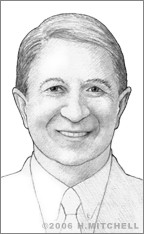Robert Gore
Breathable yet waterproof. When it comes to fabric, these two qualities would seem to be at odds with one another, and indeed they were, until 1969. That’s when the father-son team of Wilbert L. and Robert W. Gore developed a process that resulted in the miraculous product known as Gore-Tex, the world’s first breathable, waterproof fabric. The material is used in a wide and growing variety of products from outdoor equipment and apparel to insulation, sealants, and medical implants.
Wilbert L., who was known to all as “Bill” Gore, was an engineer with Dupont until 1957, when he left the company to launch his own business. He planned to explore innovative uses for fluorocarbon polymers. At that time, Robert, one of Bill’s five children, was a sophomore at the University of Delaware studying chemistry. Robert had discovered that a material known as PTFE, or fluoropolymer polytetrafluoroethylene – which is also known as Dupont’s Teflon – could be used as a versatile and effective insulation for electronic wires.
Bill refined his son’s idea and decided to offer PTFE cables as his firm’s first commercial product. A year later, he and his wife Genevieve began making and packaging the cables under the name of W.L. Gore & Associates in the basement of their home. Their “Multi-Tet” insulated wire and cable brought them significant success, and by 1961, they moved the business into a plant in Newark, Delaware.
Salt Lake City, Utah-born Robert, meanwhile, continued with his studies and completed MS and PhD degrees in chemical engineering at the University of Minnesota. After graduating in 1963, he turned his full attention to the family business, which was growing rapidly, with a presence in West Germany and Japan and a new plant in Flagstaff, Ariz. by 1967. In 1969, Gore cable was included in equipment that traveled to the moon with NASA’s Apollo 11 mission.
The company’s most significant breakthrough, however, came in 1969 when Robert developed a process to stretch PTFE into a thin, porous membrane, line it with a urethane coating, then bond it to a nylon or polyester fabric. The membrane’s pores were small enough for air to pass through, but too small for droplets of water to penetrate, making it both breathable and waterproof. He and his father perfected the material and dubbed it "Gore-Tex." Needle holes, which were created by sewing pieces of the Gore-Tex fabric together, would be covered with the company’s Gore-Tex tape in order to make the seal perfect. They began marketing the product in 1971.
Success would prove difficult to achieve, however, because people had a hard time believing such a product could work as well as its makers said that it would. A Seattle, Wash.-based maker of outdoor equipment was willing to take a chance. In 1976, Early Winters, Ltd., began making and selling Gore-Tex tents and, the next year, Gore-Tex rainwear. The 1977 Early Winters’ catalog advertised Gore-Tex rainwear as "possibly the most versatile piece of clothing you'll ever wear."
Gore-Tex quickly proved its worth, and many other manufacturers and retailers began selling Gore-Tex products, while other industries began finding new uses for the material. By 1981, Gore-Tex clothing and equipment could be found in retail stores around the world, as well as in a variety of implantable medical products, including artificial arteries for heart patients. By the mid-1980s, Gore-Tex was a household name brand.
W.L. Gore & Associates, meanwhile, continued to grow its product line, with Bill, Robert, and others on their team creating more and more products and finding ever more innovative uses for the firm’s inventions. The company launched its Windstopper fabric in 1991, a windproof, breathable fabric that is similar to Gore-Tex but is not waterproof. In 1992, the firm launched Glide brand dental floss, and in 1997, it began selling its Elixir guitar strings. The company built up four divisions – fabrics, medical, industrial, and electronic products – and continues to open itself to new possibilities, such as fuel cells. Still based in Newark, Delaware, Gore operates in 45 locations worldwide and has annual revenues in excess of $1.5 billion.
Robert served as president of W.L. Gore & Associates from 1976 to 2000 and continued to serve as chairman of the company’s board of directors for many years after that. His father Bill died in 1986. Both were honored with numerous awards and distinctions over the course of their careers. Robert was awarded the 2003 Winthrop-Sears Medal and the 2005 Perkin Medal. He was inducted into the National Inventors Hall of Fame in 2006.
On September 17, 2020, Robert Gore sadly passed away due to a prolonged illness. He was 83 years old.


